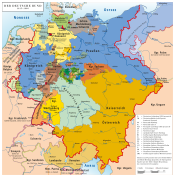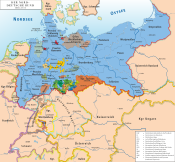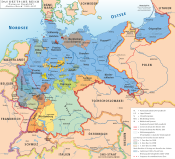| Revision as of 21:03, 24 May 2015 editDawnseeker2000 (talk | contribs)Autopatrolled, Extended confirmed users, File movers, New page reviewers, Pending changes reviewers, Rollbackers489,737 editsm Typo fixing, typo(s) fixed: avrage → average, Scince → Science, succses → success, a average → an average using AWB← Previous edit | Revision as of 04:57, 9 June 2015 edit undoPackerfansam (talk | contribs)Autopatrolled, Extended confirmed users, Pending changes reviewers47,555 edits →Religion: simplifiedNext edit → | ||
| Line 325: | Line 325: | ||
| ===Religion=== | ===Religion=== | ||
| In late 2009, 30% of the population belonged to the ], the largest religious body, and 10% to the ].<ref>http://www.ekd.de/download/Ber_Kirchenmitglieder_2009.pdf</ref> | In late 2009, 30% of the population belonged to the ], the largest religious body, and 10% to the ].<ref>http://www.ekd.de/download/Ber_Kirchenmitglieder_2009.pdf</ref> Hamburg is seat of ] of the ] and seat of the ]. | ||
| According to one 2011 estimate based on ethnic origin, there are 200,000<ref name="welt.de">{{cite web|url=http://www.welt.de/politik/deutschland/article108636429/Warum-Hamburger-Muslime-drei-Feiertage-erhalten.html |title=Staatsvertrag : Warum Hamburger Muslime drei Feiertage erhalten – Nachrichten Politik – Deutschland – DIE WELT |publisher=Welt.de |date=23 November 2011 |accessdate=12 March 2013}}</ref> ] of whom 50,000 are ],<ref name="welt.de"/> although Alevis do not always identify themselves as Muslims. | |||
| Hamburg is seat of ] of the ] and seat of the ]. There are several mosques, including the ] run ], which is the oldest in the city,<ref>{{cite news | url=http://www.abendblatt.de/hamburg/article473742/Deutschlands-aelteste-Moschee-wurde-50.html | title=Deutschlands älteste Moschee wurde 50 | date=June 19, 2007 | accessdate=June 8, 2014}}</ref> the ], and a ] community.<ref>{{Citation |first=Dovid |last=Zaklikowski |url=http://www.chabad.org/news/article_cdo/aid/561998/jewish/School-Returns-to-Hamburg-Building-Left-Judenrein.htm |title=Jewish School Returns to Hamburg Building Left Judenrein by Nazis |date=30 August 2007 |accessdate=11 August 2008 |publisher=chabad.org}}</ref> | |||
| ==Government== | ==Government== | ||
Revision as of 04:57, 9 June 2015
This article is about the German city. For other uses, see Hamburg (disambiguation).
Hamburg (/ˈhæmbɜːrɡ/; Template:IPA-de, local pronunciation Template:IPA-dedia; Low German/Low Saxon: Hamborg Template:IPA-dedia), officially Freie und Hansestadt Hamburg (Free and Hanseatic City of Hamburg), is the second largest city in Germany and the ninth largest city in the European Union. It is also the thirteenth largest German state. Its population is over 1.8 million people, and the Hamburg Metropolitan Region (including parts of the neighbouring Federal States of Lower Saxony and Schleswig-Holstein) has more than 5 million inhabitants. The port of Hamburg, on the river Elbe, is the second largest port in Europe (after the Port of Rotterdam) and tenth largest worldwide.
The official name reflects its history as a member of the medieval Hanseatic League, as a free imperial city of the Holy Roman Empire, a city-state, and one of the 16 states of Germany. Before the 1871 Unification of Germany, it was a fully sovereign state. Prior to the constitutional changes in 1919, the stringent civic republic was ruled by a class of hereditary grand burghers or Hanseaten.
Hamburg is a major transport hub and is one of the most affluent cities in Europe. It has become a media and industrial centre, with plants and facilities belonging to Airbus, Blohm + Voss and Aurubis. The radio and television broadcaster Norddeutscher Rundfunk and publishers such as Gruner + Jahr and Spiegel-Verlag are pillars of the important media industry in Hamburg. Hamburg has been an important financial centre for centuries, and is the seat of the world's second oldest bank, Berenberg Bank. There are more than 120,000 enterprises.
The city is a notable tourist destination for both domestic and overseas visitors; it ranked 17th in the world for livability in 2012.
Geography
Hamburg is on the southern point of the Jutland Peninsula, between Continental Europe to the south and Scandinavia to the north, with the North Sea to the west and the Baltic Sea to the north-east. It is on the River Elbe at its confluence with the Alster and Bille. The city centre is around the Binnenalster ("Inner Alster") and Außenalster ("Outer Alster"), both formed by damming the River Alster to create lakes. The island of Neuwerk and two small neighbouring islands Scharhörn and Nigehörn, in the Hamburg Wadden Sea National Park, are also part of Hamburg.
The neighbourhoods of Neuenfelde, Cranz, Francop and Finkenwerder are part of the Altes Land (old land) region, the largest contiguous fruit-producing region in Central Europe. Neugraben-Fischbek has Hamburg's highest elevation, the Hasselbrack at 116.2 metres (381 ft) AMSL.
Climate
Hamburg has an oceanic climate (Cfb), influenced by its proximity to the coast and marine air masses that originate over the Atlantic Ocean. Nearby wetlands also enjoy a maritime temperate climate. Measurable Snowfall is rare, generally occurring once or twice a year.
The warmest months are June, July, and August, with high temperatures of 20.1 to 22.5 °C (68.2 to 72.5 °F). The coldest are December, January, and February, with low temperatures of −0.3 to 1.0 °C (31.5 to 33.8 °F).
| Climate data for Hamburg | |||||||||||||
|---|---|---|---|---|---|---|---|---|---|---|---|---|---|
| Month | Jan | Feb | Mar | Apr | May | Jun | Jul | Aug | Sep | Oct | Nov | Dec | Year |
| Record high °C (°F) | 14.4 (57.9) |
17.2 (63.0) |
23.0 (73.4) |
29.7 (85.5) |
33.5 (92.3) |
34.6 (94.3) |
36.9 (98.4) |
37.3 (99.1) |
32.3 (90.1) |
26.1 (79.0) |
20.2 (68.4) |
15.7 (60.3) |
37.3 (99.1) |
| Mean daily maximum °C (°F) | 3.9 (39.0) |
4.6 (40.3) |
8.2 (46.8) |
13.3 (55.9) |
17.8 (64.0) |
20.1 (68.2) |
23.5 (74.3) |
22.5 (72.5) |
18.9 (66.0) |
13.4 (56.1) |
8.3 (46.9) |
4.4 (39.9) |
13.2 (55.8) |
| Daily mean °C (°F) | 1.7 (35.1) |
1.9 (35.4) |
4.6 (40.3) |
8.6 (47.5) |
12.9 (55.2) |
15.6 (60.1) |
18.7 (65.7) |
17.8 (64.0) |
14.0 (57.2) |
10.6 (51.1) |
6.2 (43.2) |
2.4 (36.3) |
9.4 (48.9) |
| Mean daily minimum °C (°F) | −0.1 (31.8) |
−0.3 (31.5) |
1.1 (34.0) |
4.7 (40.5) |
8.1 (46.6) |
10.9 (51.6) |
13.8 (56.8) |
13.3 (55.9) |
10.8 (51.4) |
7.3 (45.1) |
4.0 (39.2) |
1.0 (33.8) |
6.2 (43.2) |
| Record low °C (°F) | −22.8 (−9.0) |
−29.1 (−20.4) |
−15.3 (4.5) |
−7.1 (19.2) |
−5.0 (23.0) |
0.6 (33.1) |
3.4 (38.1) |
1.8 (35.2) |
−1.2 (29.8) |
−7.1 (19.2) |
−15.4 (4.3) |
−18.5 (−1.3) |
−19.1 (−2.4) |
| Average rainfall mm (inches) | 67.8 (2.67) |
49.9 (1.96) |
67.7 (2.67) |
43.0 (1.69) |
57.4 (2.26) |
78.6 (3.09) |
76.7 (3.02) |
78.9 (3.11) |
67.4 (2.65) |
67.0 (2.64) |
69.2 (2.72) |
68.9 (2.71) |
792.6 (31.20) |
| Average rainy days (≥ 1.0 mm) | 12.1 | 9.2 | 11.3 | 8.9 | 9.6 | 11.3 | 11.4 | 10.2 | 10.8 | 10.5 | 11.7 | 12.4 | 129.4 |
| Mean monthly sunshine hours | 46.9 | 69.0 | 108.8 | 171.6 | 223.4 | 198.7 | 217.5 | 203.1 | 144.6 | 107.9 | 53.0 | 37.4 | 1,581.9 |
| Source 1: World Meteorological Organisation (UN) | |||||||||||||
| Source 2: Deutscher Wetterdienst | |||||||||||||
History
Main article: History of Hamburg See also: Timeline of Hamburg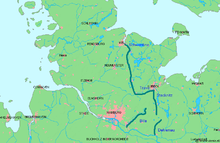
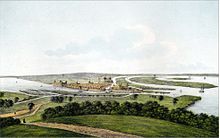
| Year | Pop. | ±% |
|---|---|---|
| 950 | 500 | — |
| 1430 | 16,000 | +3100.0% |
| 1840 | 136,956 | +756.0% |
| 1900 | 705,738 | +415.3% |
| 1910 | 931,035 | +31.9% |
| 1920 | 1,026,989 | +10.3% |
| 1930 | 1,145,124 | +11.5% |
| 1940 | 1,725,500 | +50.7% |
| 1950 | 1,605,606 | −6.9% |
| 1961 | 1,840,543 | +14.6% |
| 1970 | 1,793,640 | −2.5% |
| 1980 | 1,645,095 | −8.3% |
| 1990 | 1,652,363 | +0.4% |
| 2000 | 1,715,392 | +3.8% |
| 2010 | 1,786,448 | +4.1% |
| 2012 | 1,734,272 | −2.9% |
| 2013 | 1,746,342 | +0.7% |
Origins
Claudius Ptolemy (2nd century CE) reported the first name for the vicinity as Treva.
The name Hamburg comes from the first permanent building on the site, a castle which the Emperor Charlemagne ordered constructed in AD 808. It rose on rocky terrain in a marsh between the River Alster and the River Elbe as a defence against Slavic incursion, and acquired the name Hammaburg, burg meaning castle or fort. The origin of the Hamma term remains uncertain, as does the exact location of the castle.
Medieval Hamburg
In 834, Hamburg was designated as the seat of a bishopric. The first bishop, Ansgar, became known as the Apostle of the North. Two years later, Hamburg was united with Bremen as the bishopric of Hamburg-Bremen.
Hamburg was destroyed and occupied several times. In 845, 600 Viking ships sailed up the River Elbe and destroyed Hamburg, at that time a town of around 500 inhabitants. In 1030, King Mieszko II Lambert of Poland burned down the city. Valdemar II of Denmark raided and occupied Hamburg in 1201 and in 1214. The Black Death killed at least 60% of the population in 1350. Hamburg experienced several great fires, most notably in 1284 and 1842.


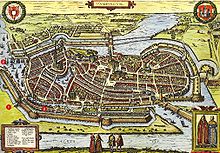

In 1189, by imperial charter, Frederick I "Barbarossa" granted Hamburg the status of an Imperial Free City and tax-free access up the Lower Elbe into the North Sea. In 1265, an allegedly forged letter was presented to or by the Rath of Hamburg. This charter, along with Hamburg's proximity to the main trade routes of the North Sea and Baltic Sea, quickly made it a major port in Northern Europe. Its trade alliance with Lübeck in 1241 marks the origin and core of the powerful Hanseatic League of trading cities. On 8 November 1266, a contract between Henry III and Hamburg's traders allowed them to establish a hanse in London. This was the first time in history that the word hanse was used for the trading guild of the Hanseatic League. In 1270, the solicitor of the senate of Hamburg, Jordan von Boitzenburg, wrote the first description of civil, criminal and procedural law for a city in Germany in the German language, the Ordeelbook (Ordeel: sentence). On 10 August 1410, civil unrest forced a compromise (German: Rezeß, literally meaning: withdrawal). This is considered the first constitution of Hamburg. In 1529, the city embraced Lutheranism, and it received Reformed refugees from the Netherlands and France and, in the 17th century, Sephardi Jews from Portugal.
Modern times
When Jan van Valckenborgh introduced a second layer to the fortifications to protect against the Thirty Years War in the seventeenth century, he extended Hamburg and created a "New Town" (Neustadt) whose street names still date from the grid system of roads he introduced.
Upon the dissolution of the Holy Roman Empire in 1806, the Free Imperial City of Hamburg was not incorporated into a larger administrative area while retaining special privileges (mediatised), but became a sovereign state with the official title of the Free and Hanseatic City of Hamburg. Hamburg was briefly annexed by Napoleon I to the First French Empire (1810–1814). Russian forces under General Bennigsen finally freed the city in 1814. Hamburg re-assumed its pre-1811 status as a city-state in 1814. The Vienna Congress of 1815 confirmed Hamburg's independence and it became one of 39 sovereign states of the German Confederation (1815–1866).
In 1842, about a quarter of the inner city was destroyed in the "Great Fire." The fire started on the night of 4 May and was not extinguished until 8 May. It destroyed three churches, the town hall, and many other buildings, killing 51 people and leaving an estimated 20,000 homeless. Reconstruction took more than 40 years.
After periodic political unrest, particularly in 1848, Hamburg adopted in 1860 a democratic constitution that provided for the election of the Senate, the governing body of the city-state, by adult taxpaying males. Other innovations included the separation of powers, the separation of Church and State, freedom of the press, of assembly and association. Hamburg became a member of the North German Confederation (1866–1871) and of the German Empire (1871–1918), and maintained its self-ruling status during the Weimar Republic (1919–1933). The city experienced its fastest growth during the second half of the 19th century, when its population more than quadrupled to 800,000 as the growth of the city's Atlantic trade helped make it Europe's second-largest port. The Hamburg-America Line, with Albert Ballin as its director, became the world's largest transatlantic shipping company around the start of the 20th century. Shipping companies sailing to South America, Africa, India and East Asia were based in the city. Hamburg was the departure port for many Germans and Eastern Europeans to emigrate to the United States in the late 19th and early 20th centuries. Trading communities from all over the world established themselves there.
A major outbreak of cholera in 1892 was badly handled by the city government, which retained an unusual degree of independence for a German city. About 8,600 died in the largest German epidemic of the late 19th century, and the last major cholera epidemic in a major city of the Western world.
Second World War
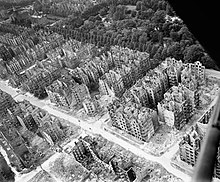

In the Third Reich (1933–1945), Hamburg was a Gau from 1934 until 1945. During World War II, Hamburg suffered a series of Allied air raids which devastated much of the city and the harbour. On 23 July 1943, a firestorm developed as a result of Allied firebombing and, spreading from the Hauptbahnhof (central train station) and quickly moving south-east, completely destroyed entire boroughs, such as Hammerbrook, Billbrook or Hamm-south. These densely populated working-class boroughs underwent a dramatic demographic change as thousands of people perished in the flames. While some of the destroyed boroughs were rebuilt as residential areas after the war, others such as Hammerbrook are nowadays purely commercial areas with almost no residential population. The raids, codenamed Operation Gomorrah by the RAF, killed at least 42,600 civilians; the precise number is not known. About 1 million civilians were evacuated in the aftermath of the raids.
The Hamburg Commonwealth War Graves Commission Cemetery is in the greater Ohlsdorf Cemetery in the north of Hamburg.
At least 42,900 people are thought to have perished in the Neuengamme concentration camp (about 25 km (16 mi) outside the city in the marshlands), mostly due to epidemics and in the bombing of Kriegsmarine evacuation vessels by the Royal Air Force at the end of the war.
In the period 1939 to 1945 the RAF dropped a total of 22,580 long tons of bombs on Hamburg.
Postwar history
Hamburg surrendered without a fight to British Forces on 3 May 1945. After World War II, Hamburg formed part of the British Zone of Occupation; it became a state of the then Federal Republic of Germany in 1949. From 1960 to 1962, the Beatles launched their career by playing in various music clubs in the city. On 16 February 1962, a North Sea flood caused the Elbe to rise to an all-time high, inundating one-fifth of Hamburg and killing more than 300 people.
The Inner German border — only 50 kilometres (30 mi) east of Hamburg — separated the city from most of its hinterland and reduced Hamburg's global trade. Since German reunification in 1990, and the accession of several Central European and Baltic States into the European Union in 2004, the Port of Hamburg has restarted ambitions for regaining its position as the region's largest deep-sea port for container shipping and its major commercial and trading centre.
Demographics
Main article: Demographics of Hamburg| Significant foreign born populations | |
| Nationality | Population (2014) |
|---|---|
| 47.553 | |
| 26.053 | |
| 20.572 | |
| 11.665 | |
| 9.329 | |
| 7.911 | |
| 7.700 | |
| 6.891 | |
| 6.534 | |
| 5.999 | |
| 5.692 | |
| 5.582 | |
On 31 December 2006, there were 1,754,182 people registered as living in Hamburg (up by 6.2% from 1,652,363 in 1990) in an area of 755.3 km (291.6 sq mi). The population density was 2,322/km (6,010/sq mi). The metropolitan area of the Hamburg region (Hamburg Metropolitan Region) is home to about 4.3 million, living on 19,000 km (7,300 sq mi).
There were 856,132 men and 898,050 women in Hamburg. For every 1,000 males, there were 1,049 females. In 2006, there were 16,089 births in Hamburg (of which 33.1% were to unmarried women); 6,921 marriages and 4,583 divorces. In the city, the population was spread out with 15.7% under the age of 18, and 18.8% were 65 years of age or older.
Recent estimates put the number of people with a migrant background at 30% (515.000). Immigrants come from 180 different countries.
In 1999, there were 910,304 households, of which 18.9% had children under the age of 18; 47.9% of all households were made up of singles. The average household size was 1.9.
Ancestry of Hamburg residents
The ancestry of Hamburg residents as at 31 December 2010 is as follows:
| Ancestry | Number |
|---|---|
| German | 71% (1 231 993) |
| Other European | 14% (240 052) |
| Asian | 6% (109 933) |
| Turkish | 5% (92 766) |
| African | 2% (34 847) |
| Hispanic and Caribbean | 1% (16 224) |
| Other/Unknown | 1% (20 958) |
Language
See also: Hamburgisch dialectLike elsewhere in Germany, Standard German is spoken in Hamburg, but as typical for northern Germany, the original language of Hamburg is Low German, usually referred to as Hamborger Platt (German Hamburger Platt) or Hamborgsch. Since large-scale Germanization beginning in earnest within the 18th century, various Low German-colored dialects have developed (contact-varieties of German on Low Saxon substrates). Originally, there was a range of such Missingsch varieties, the best-known being the low-prestige ones of the working classes and the somewhat more bourgeois Hanseatendeutsch (Hanseatic German), although the term is used in appreciation. All of these are now moribund due to the influences of Standard German used by education and media. However, the former importance of Low German is indicated by several songs, such as the famous sea shanty Hamborger Veermaster, written in the 19th century when Low German was used more frequently. Many toponyms and street names reflect Low Saxon vocabulary, partially even in Low Saxon spelling, which is not standardised, and to some part in forms adapted to Standard German.
Religion
In late 2009, 30% of the population belonged to the North Elbian Evangelical Lutheran Church, the largest religious body, and 10% to the Roman Catholic Church. Hamburg is seat of one of the three bishops of the Evangelical Lutheran Church in Northern Germany and seat of the Roman Catholic Archdiocese of Hamburg.
Government
Further information: Government of Hamburg and List of mayors of Hamburg
The city of Hamburg is one of 16 German states, therefore the Mayor of Hamburg's office corresponds more to the role of a minister-president than to the one of a city mayor. As a German state government, it is responsible for public education, correctional institutions and public safety; as a municipality, it is additionally responsible for libraries, recreational facilities, sanitation, water supply and welfare services.
Since 1897, the seat of the government has been the Hamburg Rathaus, with the office of the mayor, the meeting room for the Senate and the floor for the Hamburg Parliament. From 2001 until 2010, the mayor of Hamburg was Ole von Beust, who governed in Germany's first statewide "black-green" coalition, consisting of the conservative CDU and the alternative GAL, which are Hamburg's regional wing of the Alliance '90/The Greens party. Von Beust was briefly succeeded by Christoph Ahlhaus in 2010, but the coalition broke apart on November, 28. 2010. On 7 March 2011 Olaf Scholz (SPD) became mayor.
Boroughs
Main article: Boroughs and quarters of Hamburg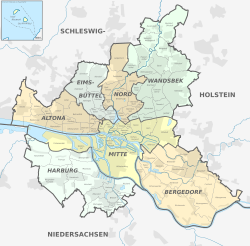
Hamburg is made up of seven boroughs (German: Bezirke) and subdivided into 104 quarters (German: Stadtteile). There are 181 localities (German: Ortsteile). The urban organization is regulated by the Constitution of Hamburg and several laws. Most of the quarters were former independent cities, towns or villages annexed into Hamburg proper. The last large annexation was done through the Greater Hamburg Act of 1937, when the cities Altona, Harburg and Wandsbek were merged into the state of Hamburg. The Act of the Constitution and Administration of Hanseatic city of Hamburg established Hamburg as a state and a municipality. Some of the boroughs and quarters have been rearranged several times.
Each borough is governed by a Borough Council (German: Bezirksversammlung) and administered by a Municipal Administrator (German: Bezirksamtsleiter). The boroughs are not independent municipalities: their power is limited and subordinate to the Senate of Hamburg. The borough administrator is elected by the Borough Council and thereafter requires confirmation and appointment by Hamburg's Senate. The quarters have no governing bodies of their own.

In 2008, the boroughs were Altona, Bergedorf, Eimsbüttel, Hamburg-Mitte, Hamburg-Nord, Harburg and Wandsbek.
Altona is the westernmost urban borough, on the right bank of the Elbe river. From 1640 to 1864, Altona was under the administration of the Danish monarchy. Altona was an independent city until 1937. Politically, the following quarters are part of Altona: Altona-Altstadt, Altona-Nord, Bahrenfeld, Ottensen, Othmarschen, Groß Flottbek, Osdorf, Lurup, Nienstedten, Blankenese, Iserbrook, Sülldorf, Rissen, Sternschanze.
Bergedorf consists of the quarters Allermöhe, Altengamme, Bergedorf—the centre of the former independent town, Billwerder, Curslack, Kirchwerder, Lohbrügge, Moorfleet, Neuengamme, Neuallermöhe, Ochsenwerder, Reitbrook, Spadenland and Tatenberg.
Eimsbüttel is split into nine quarters: Eidelstedt, Eimsbüttel, Harvestehude, Hoheluft-West, Lokstedt, Niendorf, Rotherbaum, Schnelsen and Stellingen. Located within this borough is former Jewish neighbourhood Grindel.
Hamburg-Mitte ("Hamburg Centre") covers mostly the urban centre of the city and consists of the quarters Billbrook, Billstedt, Borgfelde, Finkenwerder, HafenCity, Hamm, Hammerbrook, Horn, Kleiner Grasbrook, Neuwerk, Rothenburgsort, St. Georg, St. Pauli, Steinwerder, Veddel, Waltershof and Wilhelmsburg. The quarters Hamburg-Altstadt ("old town") and Neustadt ("new town") are the historical origin of Hamburg.
Hamburg-Nord contains the quarters Alsterdorf, Barmbek-Nord, Barmbek-Süd, Dulsberg, Eppendorf, Fuhlsbüttel, Groß Borstel, Hoheluft-Ost, Hohenfelde, Langenhorn, Ohlsdorf with Ohlsdorf cemetery, Uhlenhorst and Winterhude.
Harburg lies on the southern shores of the river Elbe and covers parts of the port of Hamburg, residential and rural areas, and some research institutes. The quarters are Altenwerder, Cranz, Eißendorf, Francop, Gut Moor, Harburg, Hausbruch, Heimfeld, Langenbek, Marmstorf, Moorburg, Neuenfelde, Neugraben-Fischbek, Neuland, Rönneburg, Sinstorf and Wilstorf.
Wandsbek is divided into the quarters Bergstedt, Bramfeld, Duvenstedt, Eilbek, Farmsen-Berne, Hummelsbüttel, Jenfeld, Lemsahl-Mellingstedt, Marienthal, Poppenbüttel, Rahlstedt, Sasel, Steilshoop, Tonndorf, Volksdorf, Wandsbek, Wellingsbüttel and Wohldorf-Ohlstedt.
Cityscape
 A panoramic view of the Hamburg skyline of the Binnenalster taken from Lombardsbrücke.
A panoramic view of the Hamburg skyline of the Binnenalster taken from Lombardsbrücke.
Architecture

Hamburg has architecturally significant buildings in a wide range of styles and only a few skyscrapers. Churches are important landmarks, such as St Nicholas', which for a short time in the 19th century was the world's tallest building. The skyline features the tall spires of the most important churches (Hauptkirchen) St Michael's (nicknamed “Michel"), St Peter's, St James's (St. Jacobi) and St. Catherine's covered with copper plates, and the Heinrich-Hertz-Turm, the radio and television tower (no longer publicly accessible).

The many streams, rivers and canals are crossed by over 2400 bridges, more than London, Amsterdam and Venice put together. Hamburg has more bridges inside its city limits than any other city in the world and more canals than Amsterdam and Venice combined. The Köhlbrandbrücke, Freihafen Elbbrücken, and Lombardsbrücke and Kennedybrücke dividing Binnenalster from Aussenalster are important roadways.
The town hall is a richly decorated Neo-Renaissance building finished in 1897. The tower is 112 metres (367 ft) high. Its façade, 111 m (364 ft) long, depicts the emperors of the Holy Roman Empire, since Hamburg was, as a Free Imperial City, only under the sovereignty of the emperor. The Chilehaus, a brick expressionist office building built in 1922 and designed by architect Fritz Höger, is shaped like an ocean liner.
Europe's largest inner-city development in 2008, the HafenCity, will house about 10,000 inhabitants and 15,000 workers. The plan includes designs by Rem Koolhaas and Renzo Piano. The Elbe Philharmonic Hall (Elbphilharmonie), expected to be completed by December 2016, will house concerts in a building on top of an old warehouse, designed by the Swiss architects Herzog & de Meuron.
The many parks are distributed over the whole city, which makes Hamburg a very verdant city. The biggest parks are the Stadtpark, the Ohlsdorf Cemetery and Planten un Blomen. The Stadtpark, Hamburg's "Central Park", has a great lawn and a huge water tower, which houses one of Europe's biggest planetaria. The park and its buildings were designed by Fritz Schumacher in the 1910s.
Parks and gardens
The Alter Botanischer Garten Hamburg is a historic botanical garden, located in the Planten un Blomen park, which now consists primarily of greenhouses. The Botanischer Garten Hamburg is a modern botanical garden maintained by the University of Hamburg. Besides these, there are many more big and small parks. In 2010 Hamburg was voted "greenest city of Europe" by the EU commission. In 2014 Hamburg celebrated a birthday of park culture, where many parks were reconstructed and cleaned up.
Culture and contemporary life
Hamburg has more than 40 theatres, 60 museums and 100 music venues and clubs. In 2005, more than 18 million people visited concerts, exhibitions, theatres, cinemas, museums, and cultural events. More than 8,552 taxable companies (average size 3.16 employees) were engaged in the culture sector, which includes music, performing arts and literature. There are five companies in the creative sector per thousand residents (as compared to three in Berlin and 37 in London). Hamburg has entered the European Green Capital Award scheme, and was awarded the title of European Green Capital for 2011.
Theatres
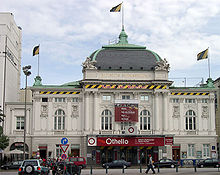

The state-owned Deutsches Schauspielhaus, the Thalia Theatre, "Ohnsorg Theatre", "Schmidts Tivoli" and the Kampnagel are well-known theatres.
The English Theatre of Hamburg near U3 Mundsburg station was established in 1976 and is the oldest professional English-speaking theatre in Germany, and has exclusively English native-speaking actors in its company.
Museums
Hamburg has several large museums and galleries showing classical and contemporary art, for example the Kunsthalle Hamburg with its contemporary art gallery (Galerie der Gegenwart), the Museum for Art and Industry (Museum für Kunst und Gewerbe) and the Deichtorhallen/House of Photography. The Internationales Maritimes Museum Hamburg opened in the HafenCity quarter in 2008. There are various specialised museums in Hamburg, such as the Archaeological Museum Hamburg (Archäologisches Museum Hamburg) in Hamburg-Harburg, the Museum of Labour (Museum der Arbeit), and several museums of local history, for example the Kiekeberg Open Air Museum (Freilichtmuseum am Kiekeberg). Two museum ships near Landungsbrücken bear witness to the freight ship (Cap San Diego) and cargo sailing ship era (Rickmer Rickmers). The world's largest model railway museum Miniatur Wunderland with 12 km (7.46 mi) total railway length is also situated near Landungsbrücken in a former warehouse.
BallinStadt Emigration City is dedicated to the millions of Europeans who emigrated to North and South America between 1850 and 1939. Visitors descending from those overseas emigrants may search for their ancestors at computer terminals.
Music
Hamburg State Opera is a leading opera company. Its orchestra is the Philharmoniker Hamburg. The city's other well-known orchestra is the North German Radio Symphony Orchestra. The main concert venue is the Laeiszhalle, Musikhalle Hamburg, pending completion of the new Elbe Philharmonic Hall. The Laeiszhalle also houses a third orchestra, the Hamburger Symphoniker. György Ligeti and Alfred Schnittke taught at the Hochschule für Musik und Theater Hamburg.
Since the German premiere of Cats in 1985, there have always been musicals running, including The Phantom of the Opera, The Lion King, Dirty Dancing, and Dance of the Vampires. This density, the highest in Germany, is partly due to the major musical production company Stage Entertainment being based in the city.
Hamburg is the birthplace of Johannes Brahms, who spent his formative early years in the city, and the birthplace and home of the famous waltz composer Oscar Fetrás, who wrote the well-known "Mondnacht auf der Alster" waltz.
Prior to the group's initial recording and widespread fame, Hamburg provided residency and performing venues for The Beatles from 1960 to 1962. Hamburg has nurtured a number of pop musicians. Identical twins Bill Kaulitz and Tom Kaulitz from the rock band Tokio Hotel live and maintain a recording studio in Hamburg, where they recorded their second and third albums, Zimmer 483 and Humanoid. Singer Nena also lives in Hamburg. There are German hip hop acts, such as Fünf Sterne deluxe, Samy Deluxe, Beginner and Fettes Brot. There is a substantial alternative and punk scene, which gathers around the Rote Flora, a squatted former theatre located in the Sternschanze. Hamburg is famous for an original kind of German alternative music called Hamburger Schule ("Hamburg School"), a term used for bands like Tocotronic, Blumfeld, Tomte or Kante.
The city was a major centre for heavy metal music in the 1980s. Helloween, Gamma Ray, Running Wild and Grave Digger started in Hamburg. The industrial rock band KMFDM was also formed in Hamburg, initially as a performance art project. The influences of these and other bands from the area helped establish the subgenre of power metal.
Hamburg has a vibrant psychedelic trance community, with record labels such as Spirit Zone.
Festivals and regular events
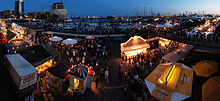
Hamburg is noted for several festivals and regular events. Some of them are street festivals, such as the gay pride Christopher Street Day festival or the Alster fair, held at the Binnenalster. The Hamburger DOM is northern Germany's biggest fun fair, held three times a year. Hafengeburtstag is a funfair to honour the birthday of the port of Hamburg with a party and a ship parade. The biker's service in Saint Michael's Church attracts tens of thousands of bikers. Christmas markets in December are held at the Hamburg Rathaus square, among other places. The long night of museums offers one entrance fee for about 40 museums until midnight. The sixth Festival of Cultures was held in September 2008, celebrating multi-cultural life. The Filmfest Hamburg — a film festival originating from the 1950s Film Days (German: Film Tage) — presents a wide range of films. The Hamburg Messe and Congress offers a venue for trade shows, such hanseboot, an international boat show, or Du und deine Welt, a large consumer products show. Regular sports events—some open to pro and amateur participants—are the cycling competition Vattenfall Cyclassics, the Hamburg Marathon, the biggest marathon in Germany after Berlin, the tennis tournament Hamburg Masters and equestrian events like the Deutsches Derby. Since 2007, Hamburg has the Dockville music and art festival. It takes place every year in summer in Wilhelmsburg.
Cuisine

Original Hamburg dishes are Birnen, Bohnen und Speck (green beans cooked with pears and bacon), Aalsuppe (Hamburgisch Oolsupp) is often mistaken to be German for “eel soup“ (Aal/Ool translated ‘eel’), but the name probably comes from the Low Saxon allns , meaning “all”, “everything and the kitchen sink”, not necessarily eel. Today eel is often included to meet the expectations of unsuspecting diners. There is Bratkartoffeln (pan-fried potato slices), Finkenwerder Scholle (Low Saxon Finkwarder Scholl, pan-fried plaice), Pannfisch (pan-fried fish with mustard sauce), Rote Grütze (Low Saxon Rode Grütt, related to Danish rødgrød, a type of summer pudding made mostly from berries and usually served with cream, like Danish rødgrød med fløde) and Labskaus (a mixture of corned beef, mashed potatoes and beetroot, a cousin of the Norwegian lapskaus and Liverpool's lobscouse, all offshoots off an old-time one-pot meal that used to be the main component of the common sailor's humdrum diet on the high seas).
Alsterwasser (in reference to the city's river, the Alster) is the local name for a type of shandy, a concoction of equal parts of beer and carbonated lemonade (Zitronenlimonade), the lemonade being added to the beer.
There is the curious regional dessert pastry called Franzbrötchen. Looking rather like a flattened croissant, it is similar in preparation but includes a cinnamon and sugar filling, often with raisins or brown sugar streusel. The name may also reflect to the roll's croissant-like appearance – franz appears to be a shortening of französisch, meaning "French", which would make a Franzbrötchen a “French roll.” Ordinary bread rolls tend to be oval-shaped and of the French bread variety. The local name is Schrippe (scored lengthways) for the oval kind and, for the round kind, Rundstück (“round piece” rather than mainstream German Brötchen, diminutive form of Brot “bread”), a relative of Denmark's rundstykke. In fact, while by no means identical, the cuisines of Hamburg and Denmark, especially of Copenhagen, have a lot in common. This also includes a predilection for open-faced sandwiches of all sorts, especially topped with cold-smoked or pickled fish.
The American hamburger seems to have developed from Hamburg's Frikadelle: a pan-fried patty (usually larger and thicker than its American counterpart) made from a mixture of ground beef, soaked stale bread, egg, chopped onion, salt and pepper, usually served with potatoes and vegetables like any other piece of meat, not usually on a bun. The Oxford Dictionary defined a Hamburger steak in 1802: a sometimes-smoked and -salted piece of meat, that, according to some sources, came from Hamburg to America. The name and food, "hamburger", has entered all English-speaking countries, and derivative words in non-English speaking countries.
There are restaurants which offer most of these dishes, especially in the Hafencity, which started to be built in 2008 with 155 hectares (380 acres) and 13 quarters. This district increases the city centre by about 40%, with restaurants and apartments.
Main sights
-
 The Port of Hamburg
The Port of Hamburg
-
 Hamburg Rathaus
Hamburg Rathaus
-
 St. Michael's Church ("Michel")
St. Michael's Church ("Michel")
-
 Ruins of the St. Nicholas' Church
Ruins of the St. Nicholas' Church
-
 The MS Freedom of the Seas behind St. Pauli Piers
The MS Freedom of the Seas behind St. Pauli Piers
-
 Elbe Philharmonic Hall ("Elbphilharmonie") under construction
Elbe Philharmonic Hall ("Elbphilharmonie") under construction
-
 Warehouse district (Speicherstadt)
Warehouse district (Speicherstadt)
-
 HafenCity
HafenCity
-
 Reeperbahn, entertainment district of St. Pauli quarter
Reeperbahn, entertainment district of St. Pauli quarter
-
 Große Freiheit ("Great Freedom") next to Reeperbahn
Große Freiheit ("Great Freedom") next to Reeperbahn
-
 The Dockland at night
The Dockland at night
-
 View over frozen Alster towards Radisson Hotel and Hertz-Turm
View over frozen Alster towards Radisson Hotel and Hertz-Turm
-
 Planten un Blomen park
Planten un Blomen park
-
 The Jungfernstieg Boulevard
The Jungfernstieg Boulevard
-
Hills and mansions in Blankenese
- Hamburg State Opera Hamburg State Opera
-
 The Lion King musical theatre
The Lion King musical theatre
-
Köhlbrand Bridge
-
 Hanseatisches Oberlandesgericht ("HansOLG"), upper court
Hanseatisches Oberlandesgericht ("HansOLG"), upper court
-
Hamburg Hauptbahnhof, the busiest railway station in Germany
-
Highrises in St. Pauli
-
 View over Hamburg and the Alster
View over Hamburg and the Alster
English culture
There are several English-speaking communities, such as Caledonian Society of Hamburg, The British Club Hamburg, British and Commonwealth Luncheon Club, Professional Women's Forum, The British Decorative and Fine Arts Society, The English Speaking Union of the Commonwealth, The Scottisch Country Dancers of Hamburg. There is also a thriving 400 year old Anglican church community worshiping at St Thomas Becket Church. Further The Hamburg Players e. V. English Language Theatre Group, The Hamburg Exiles Rugby Club, The Hamburger Cricket Verein e. V., The Morris Minor Register of Hamburg.
American and international English-speaking organisations are The American Club of Hamburg e.V., the American Women's Club of Hamburg, the English Speaking Union, and the German-American Women's Club., The International Women's Club of Hamburg e. V.. Business themes are dealt with by The American Chamber of Commerce. The International School of Hamburg serves school children.
Memorials
A memorial for successful English engineer William Lindley, who reorganized, beginning in 1842, the drinking water and sewage system and thus helped to fight against cholera, is near Baumwall train station in Vorsetzen street.
In 2009, more than 2,500 "stumbling blocks" (Stolpersteine) were laid, engraved with the names of deported and murdered citizens. Inserted into the pavement in front of their former houses, the blocks draw attention to the victims of Nazi persecution.
Economy

The 2007 gross domestic product (GDP) totaled €88.9 billion. The city has the highest GDP per capita – over €50,000 – of all the German states, and a relatively high employment rate, at 88 percent of the working-age population, employed in over 120,000 businesses. In 2007, the average income of employees was €30,937.
Banking

Hamburg has for centuries been a commercial centre of Northern Europe, and is the most important banking city of Northern Germany. The city is the seat of Germany's oldest bank, the Berenberg Bank, M.M.Warburg & CO and HSH Nordbank.
Port
The most significant economic unit is the Port of Hamburg, which ranks second only to Rotterdam in Europe and ninth worldwide with transshipments of 9.8 million twenty-foot equivalent units (TEU) of cargo and 134 million tons of goods in 2007. After German reunification, Hamburg recovered the eastern portion of its hinterland, becoming by far the fastest-growing port in Europe. International trade is also the reason for the large number of consulates in the city. Although situated 68 miles (110 km) up the Elbe, it is considered a sea port due to its ability to handle large ocean-going vessels. Hamburg, along with Seattle and Toulouse, is an important location of the civil aerospace industry. Airbus, which has an assembly plant in Finkenwerder, employs over 13,000 people.
Heavy industry includes the making of steel, aluminium, copper and shipyards such as Blohm + Voss.
HafenCity
The HafenCity is a new large urban development project in the Hamburg-Mitte district. It consists of the area of the Great Grasbrook, the northern part of the former Elbe island Grasbrook, and the warehouse district on the former Elbe island Kehrwieder and Wandrahm. It is bordered to the north, separated by the customs channel to Hamburg's city center, west and south by the Elbe and to the east, bounded by the upper harbor, Rothenburgsort. The district is full of rivers and streams and is surrounded by channels, and has a total area of about 2.2 square-kilometers.
HafenCity has 155 hectares in the area formerly belonging to the free port north of the Great Grasbrook. Until around the mid-2020s residential units for up to 12,000 people are planned to be built on the site, and jobs for up to 40,000 people, mainly in the office sector should be created. It is the largest ongoing urban development project in Hamburg.
Construction work started in 2003, and in 2009 the first part of the urban development project was finished with the completion of the Dalmannkai / Sandtorkai neighborhood – which is the first stage of the HafenCity project. According to the person responsible for the development and commercialization of HafenCity, HafenCity Hamburg GmbH, half of the master plan underlying structural construction is already completed, whereas the other half is either under construction or is in the construction preparation stages.
Many companies operating in E-Commerce have moved into HafenCity or started there. In addition to cruise agents such as the CaptainTravel GmbH many start-up companies that have no direct connection to the port or ships can be found in HafenCity.
Tourism
See also: List of museums and cultural institutions in HamburgIn 2007, more than 3,985,105 visitors with 7,402,423 overnight stays visited the city. The tourism sector employs more than 175,000 people full-time and brings in revenue of €9.3 billion, making the tourism industry a major economic force in the Hamburg Metropolitan Region. Hamburg has one of the fastest-growing tourism industries in Germany. From 2001 to 2007, the overnight stays in the city increased by 55.2% (Berlin +52.7%, Mecklenburg-Western Pomerania +33%).
A typical Hamburg visit includes a tour of the city hall and the grand church St. Michaelis (called the Michel), and visiting the old warehouse district (Speicherstadt) and the harbour promenade (Landungsbrücken). Sightseeing buses connect these points of interest. As Hamburg is one of the world's largest harbours many visitors take one of the harbour and/or canal boat tours (Große Hafenrundfahrt, Fleetfahrt) which start from the Landungsbrücken. Major destinations also include museums.
The area of Reeperbahn in the quarter St. Pauli is Europe's largest red light district and home of strip clubs, brothels, bars and nightclubs. The singer and actor Hans Albers is strongly associated with St. Pauli, and wrote the neighbourhood's unofficial anthem, "Auf der Reeperbahn Nachts um Halb Eins" ("On the Reeperbahn at Half Past Midnight") in the 1940s. The Beatles had stints on the Reeperbahn early in their careers. Others prefer the laid-back neighbourhood Schanze with its street cafés, or a barbecue on one of the beaches along the river Elbe. Hamburg's famous zoo, the Tierpark Hagenbeck, was founded in 1907 by Carl Hagenbeck as the first zoo with moated, barless enclosures.
In 2005, the average visitor spent two nights in Hamburg. The majority of visitors come from Germany. Most foreigners are European, especially from the United Kingdom (171,000 overnight stays), Switzerland (about 143,000 overnight stays), Austria (about 137,000 overnight stays) and the Netherlands (about 80,000 overnight stays). The largest group from outside Europe comes from the United States (129,000 overnight stays).
The Queen Mary 2 has docked regularly since 2004, and there were six departures planned from 2010 onwards.
Media

Media businesses employ over 70,000 people. The Norddeutscher Rundfunk which includes the television station NDR Fernsehen is based in Hamburg, as are the commercial television station Hamburg 1, the Christian television station Bibel TV and the civil media outlet Tide TV. There are regional radio stations such as Radio Hamburg. Some of Germany's largest publishing companies, Axel Springer AG, Gruner + Jahr, Bauer Media Group are located in the city. Many national newspapers and magazines such as Der Spiegel and Die Zeit are produced in Hamburg, as well as some special-interest newspapers such as Financial Times Deutschland. Hamburger Abendblatt and Hamburger Morgenpost are daily regional newspapers with a large circulation. There are music publishers, such as Warner Bros. Records Germany, and ICT firms such as Adobe Systems and Google Germany. The Internet and telecommunications company HanseNet, which sells DSL Internet access under the Alice brand, has its headquarters in Hamburg.
Hamburg was one of the locations for the James Bond series film Tomorrow Never Dies. The Reeperbahn has been the location for many scenes, including the 1994 Beatles film Backbeat. The film A Most Wanted Man was set in and filmed in Hamburg.
Infrastructure
Health systems
Hamburg has 54 hospitals. The University Medical Center Hamburg-Eppendorf, with about 1,450 beds, houses a large medical school. There are also smaller private hospitals. On 1 January 2011 there were about 11,350 hospital beds. The city had 5,663 physicians in private practice and 456 pharmacies in 2010.
Transport
Main article: Transport in Hamburg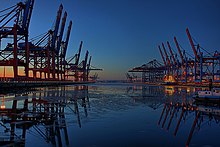
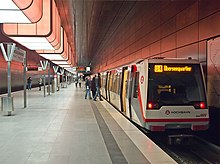

Hamburg is a major transportation hub, connected to four Autobahnen (motorways) and the most important railway junction on the route to Scandinavia.
Bridges and tunnels connect the northern and southern parts of the city, such as the old Elbe Tunnel (Alter Elbtunnel) now a major tourist sight, and the Elbe Tunnel (Elbtunnel) the crossing of a motorway.
Hamburg Airport is the oldest airport in Germany still in operation. There is also the smaller Hamburg Finkenwerder Airport, used only as a company airport for Airbus. Some airlines market Lübeck Airport in Lübeck as serving Hamburg.
Hamburg's license plate prefix was "HH" (Hansestadt Hamburg; English: Hanseatic City of Hamburg) between 1906 and 1945 and from 1956, rather than the single letter normally used for large cities since the federal registration reform in 1956, such as B for Berlin or M for Munich. "H" was Hamburg's prefix in the years between 1945 and 1947 (used by Hanover since 1956);
Public transport
Public transport by rail, bus and ship is organised by the Hamburger Verkehrsverbund ("Hamburg transit authority") (HVV). Tickets sold by one company are valid on all other HVV companies' services. The HVV was the first organisation of this kind worldwide.
- Rail
Nine mass transit rail lines across the city are the backbone of public transport. The S-bahn (heavy railway system) comprises six lines and the U-bahn four lines – U-Bahn is short for Untergrundbahn (underground railway). Approximately 41 km (25 mi) of 101 km (63 mi) of the U-bahn is underground; most is on embankments or viaduct or at ground level. Older residents still speak of the system as Hochbahn (elevated railway), also because the operating company of the subway is the Hamburger Hochbahn. The AKN railway connects satellite towns in Schleswig-Holstein to the city. On some routes regional trains of Germany's major railway company Deutsche Bahn AG and the regional metronom trains may be used with an HVV ticket. Except at the three bigger stations in the centre, Hauptbahnhof, Dammtor and Altona, regional trains do not stop inside the city. The tram network was shut down in 1978.
- Bus
Gaps in the rail network are filled by more than 600 bus routes, operated by single-deck two-, three- and four-axle diesel buses. Hamburg has no trams or trolley-buses, but has hydrogen-fueled buses operating pilot services. The buses run frequently during working hours, with buses on some routes as often as every 2 minutes. In suburban areas and on special weekday night lines the intervals can be 30 minutes or longer.
- Ferries
There are six ferry lines along the River Elbe, operated by HADAG, that fall under the aegis of the HVV. While mainly used by citizens and dock workers, they can also be used for sightseeing tours.
- Aviation

The international airport at Hamburg Fuhlsbüttel, official name "Hamburg Airport" (IATA: HAM, ICAO: EDDH) is the fifth biggest and oldest airport in Germany, having been established in 1912. It is about 5 miles (8 kilometres) from the city centre. About 60 airlines provide service to 125 destination airports, including some long distance destinations like Newark, New Jersey on United Airlines, Dubai on Emirates, and Tehran on Iran Air. Lufthansa is the hub carrier, with the most flights, followed by Air Berlin. Lufthansa operates one of its biggest maintenance facilities at the Hamburg airport.
The second airport is Hamburg-Finkenwerder (IATA: XFW, ICAO: EDHI). It is about 10 km (6 mi) from the city centre and is a nonpublic airport for the Airbus plant. It is the second biggest Airbus plant, after Toulouse, and the third biggest aviation manufacturing plant after Seattle and Toulouse. The Finkenwerder plant houses the final assembly lines for A318, A319, A320, A321 and A380 aircraft.
Utilities

Electricity for Hamburg and Northern Germany is provided by Vattenfall Europe, formerly the state-owned Hamburgische Electricitäts-Werke. Vattenfall Europe operates three nuclear power plants near Hamburg: Brokdorf Nuclear Power Plant, Brunsbüttel Nuclear Power Plant and Krümmel Nuclear Power Plant. All are scheduled to be taken out of service. There are also the coal-fired Wedel and Moorburg Power Stations, and the fuel-cell power plant in the HafenCity quarter. VERA Klärschlammverbrennung uses the biosolids of the Hamburg wastewater treatment plant; the Pumpspeicherwerk Geesthacht is a pump storage power plant and a biomass power station is Müllverwertung Borsigstraße.
Sport
Main article: Sport in Hamburg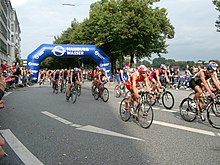


Hamburg is sometimes called Germany's capital of sport since no other city has more first-league teams and international sports events.
Hamburger SV, one of the most successful teams in Germany, is a football team in the Bundesliga. The HSV is the oldest team of the Bundesliga, playing in the league since its beginning in 1963. HSV is a six-time German champion, a three-time German cup winner and triumphed in the European Cup in 1983, and has played in the group stages of the Champions League twice: in 2000/2001 and in 2006/2007. They play at the Imtech Arena (average attendance in the 12/13 season was 52,916). In addition, FC St. Pauli was a second division football club that came in second place in the 2009/2010 season and qualified to play alongside Hamburger SV in the first division for the first time since the 2001–02 season. St. Pauli's home games take place at the Millerntor-Stadion.
The Hamburg Freezers represent Hamburg in the DEL, the premier ice hockey league in Germany.
HSV Handball represents Hamburg in the German handball league. In 2007, HSV Handball won the European Cupwinners Cup. The Club won the league in the 2010/11 season and had an average attandence of 10.690 in the O2 World Hamburg the same year. The most recent success for the team was the EHF Champions League win in 2013. Since 2014 the club has suffered from economic problems and was almost not allowed the playing licence for the 2014-15 season. But due to economic support from the former club president/sponsor Andreas Rudolf the club was allowed the license in the last minute.
Hamburg is the nation's field hockey capital and dominates the men's as well as the women's Bundesliga. Hamburg host's many top team's such as Uhlenhorster Hockey Club, Harvesterhuder Hockey Club and Club An Der Alster.
The Hamburg Warriors are one of Germany's top lacrosse clubs. The club has grown immensely in the last several years and includes at least one youth team, three men's, and two women's teams. The team participates in the Deutsch Lacrosse Verein. The Hamburg Warriors are part of the Harvestehuder Tennis- und Hockey-Club e.V (HTHC).
There are also the Hamburg Dockers, an Australian rules football club. The FC St. Pauli team dominates women's rugby in Germany. Other first-league teams include VT Aurubis Hamburg (Volleyball), Hamburger Polo Club, and Hamburg Blue Devils (American Football). There are also several minority sports clubs, including four cricket clubs.
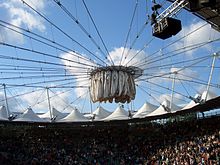
The Centre Court of the Tennis Am Rothenbaum venue, with a capacity of 13,200 people, is the largest in Germany.
Hamburg also hosts equestrian events at Reitstadion Klein Flottbek (Deutsches Derby in jumping and dressage) and Horner Rennbahn (Deutsches Derby flat racing). Besides Hamburg owns the famous harness racing track "Trabrennbahn Bahrenfeld".The Hamburg Marathon is the biggest marathon in Germany after Berlin's. In 2008 23,230 participants were registered. World Cup events in cycling, the UCI ProTour competition Vattenfall Cyclassics, and the triathlon ITU World Cup event Hamburg City Man are also held in here.
The Imtech Arena (formerly the AOL Arena or HSH Nordbank Arena and originally Volksparkstadion) was used as a site for the 2006 World Cup. In 2010 UEFA held the final of the UEFA Europa League in the arena.
Thomas Bach, President of the International Olympic Committee, stated that Hamburg will apply for 2024 Olympic Games.
Education
See also: Education in Hamburg and Education in GermanyThe school system is managed by the Ministry of Schools and Vocational Training (Behörde für Schule und Berufsbildung). The system had approximately 160,000 students in 245 primary schools and 195 secondary schools in 2006. There are 33 public libraries in Hamburg proper.
Seventeen universities are located in Hamburg, with about 70,000 university students in total, including 9,000 resident aliens. Six universities are public, including the largest, the University of Hamburg (Universität Hamburg) with the University Medical Centre of Hamburg-Eppendorf, the University of Music and Theatre, the Hamburg University of Applied Sciences and the Hamburg University of Technology. Seven universities are private, like the Bucerius Law School. The city has also smaller private colleges and universities, including many religious and special-purpose institutions, such as the Helmut Schmidt University (formerly the University of the Federal Armed Forces Hamburg). Hamburg is home to one of the oldest international schools in Germany, the International School of Hamburg.
Twin towns and sister cities
Hamburg has nine twin towns and sister cities around the world. Dar es Salaam, Tanzania became the newest sister city in 2010.Template:De icon
|
|
People from Hamburg
See also: Category:People from HamburgIn Hamburg it's hard to find a native Hamburger. A hurried and superficial search turns up only crayfish, people from Pinneberg, and those from Bergedorf. One accompanies the contented little kippers of a striving society; mackerels from Stade, sole from Finkenwerder, herrings from Cuxhaven swim in expectant throngs through the streets of my city and lobsters patrol the stock exchange with open claws.... The first so-called unguarded glance always lands on the bottom of the sea and falls into twilight of the aquarium. Heinrich Heine must have had the same experience when he tried, with his cultivated scorn and gifted melancholy, to find the people of Hamburg.
— Siegfried Lenz, in Leute von Hamburg (People of Hamburg) ISBN 978-3-423-11538-4.
See also
References
- ^ Constitution of Hamburg Verfassung der Freien und Hansestadt Hamburg (in German) (11th ed.), 6 June 1952, retrieved 21 September 2008
- "Europe's largest cities". City Mayors Statistics. Retrieved 29 December 2009.
- "2012 Quality of Living survey". Mercer.com. Retrieved 12 March 2013.
- Hamburg Wadden Sea National Park Act Gesetz über den Nationalpark Hamburgisches Wattenmeer (in German), 9 April 1990, retrieved 26 February 2011
- Geologisches Landesamt Hamburg (Hamburg State Geological Department) (2007), Statistisches Jahrbuch 2007/2008 (in German), Hamburg: Statistisches Amt für Hamburg und Schleswig-Holstein, ISSN 1614-8045
- ^ "World Weather Information Service – Hamburg". Deutscher Wetterdienst. Retrieved 6 April 2012.
- "Ausgabe der Klimadaten: Monatswerte". Retrieved 24 June 2014.
- :
- Verg, Erich; Verg, Martin (2007), Das Abenteuer das Hamburg heißt (in German) (4th ed.), Hamburg: Ellert&Richter, p. 8, ISBN 978-3-8319-0137-1
- "Hammaburg – der große Irrtum" (in German). Hamburg Abendblatt. 12 December 2007. Retrieved 30 September 2008.
- ^ Verg (2007), p.15
- Snell, Melissa (2006), The Great Mortality, Historymedren.about.com, retrieved 19 April 2009
- Verg (2007), p. 26
- Verg (2007), p. 30
-
Clark, David S. (1987), "The Medieval Origins of Modern Legal Education: Between Church and State", The American Journal of Comparative Law, Vol. 35, No. 4 (4), American Society of Comparative Law: 653–719, doi:10.2307/840129, JSTOR 840129
{{citation}}:|volume=has extra text (help) - Verg (2007), p. 39
- History of the area, accessed 3 November 2012
- "Gedenkstätte Konzentrationslager Neuengamme". Kz-gedenkstaette-neuengamme.de. Retrieved 14 September 2013.
- http://www.flightglobal.com/pdfarchive/view/1945/1945%20-%201571.html
- Ortwin Pelc, Kriegsende in Hamburg, Hamburg 2005
- "Ausländische Bevölkerung in Hamburg am 31.12.2013" (PDF). Statistisches Amt für Hamburg und Schleswig-Holstein. 26 March 2014. Retrieved 20 August 2014.
- ^ Staff (2007), Statistisches Jahrbuch 2007/2008 (in German), Hamburg: Statistical office Hamburg and Schleswig-Holstein (Statistisches Amt für Hamburg und Schleswig-Holstein), ISSN 1614-8045
- Hamburg Metropolitan Area fact sheet (PDF), Office of Statistics for Hamburg and Schleswig-Holstein (Statistisches Amt für Hamburg und Schleswig-Holstein), archived from the original (PDF) on 19 October 2007, retrieved 4 August 2008
- ^ http://www.statistik-nord.de/uploads/tx_standocuments/SI_SPEZIAL_VII_2011.pdf
- Selectable data base: Source: Residents registration office, Regionalergebnisse (in German), Statistical office Hamburg and Schleswig-Holstein, retrieved 16 June 2008
- Bausch, Karl-Heinz (2007), "Die deutsche Sprache—eine Dialektlandschaft", Nationalatlas Bundesrepublik Deutschland (PDF) (in German), Leipzig: Leibniz-Institut für Länderkunde, pp. 94–95, ISBN 3-8274-0947-0, archived from the original (PDF) on 19 July 2011, retrieved 24 September 2008
- Several places are named ...brook (Billbrook, Brooktor, Grasbrook, Hammerbrook, Hellbrook, Iserbrook) rather than Standard German ...bruch (neutr.; =brook riverscape), Bullenhusen rather than Bullenhausen, Lohbrügge rather than Lohbrücke, several localities starting with Nien... (Niendorf, Nienstedten) rather than Neuen..., or ending ...hude (Dockenhuden, Harvestehude, Winterhude) rather than ...hut (fem.; =pasture), Uhlenhorst rather than Eulenhorst, several places and water bodies are named ...bek (Barmbek, Eilbek, Fischbek, Flottbek, Goldbek, Isebek, Kirchsteinbek, Langenbek, Osterbek, Pepermölenbek, Wandsbek) rather than ...bach, several places and water bodies are called ...fleet (Alsterfleet, Bleichenfleet, Moorfleet) rather than ...fließ (=brook, stream). Further toponyms with no close Standard German correspondents appear, such as ...büttel (=inhabited place; Eimsbüttel, Fuhlsbüttel, Hummelsbüttel, Poppenbüttel, Wellingsbüttel) or Twiete (=alley wedged between buildings). Like in other parts of Northern Germany ...stedt (Bergstedt, Billstedt, Duvenstedt, Eidelstedt, Lokstedt, Mellingstedt, Nienstedten, Ohlstedt, Rahlstedt) prevails over ...stadt (=town, originally simply stead).
- http://www.ekd.de/download/Ber_Kirchenmitglieder_2009.pdf
- Kleiner Rathausführer (in German), Hamburg: State Chancellery, 2006
- German conservatives win most votes, USA today, 24 February 2008, retrieved 13 August 2008
- Kopp, Martin (12 August 2008), Geheime Absprachen zwischen CDU und Grünen (in German), Hamburg: Die Welt, archived from the original on 6 January 2009, retrieved 13 August 2008.
{{citation}}: Check date values in:|year=/|date=mismatch (help) - Schwarz-Grün in Hamburg am Ende in Die Zeit – online, revisited on November, 28. 2010.
- ^ Borough Administration Act Bezirksverwaltungsgesetz (BezVG) (in German), 6 July 2006, retrieved 21 September 2008
- Greater Hamburg Act Groß-Hamburg-Gesetz (in German), 26 January 1937, retrieved 24 September 2008
- Reich Act of the Constitution and Administration of Hanseatic city of Hamburg Reichsgesetz über die Verfassung und Verwaltung der Hansestadt Hamburg (in German), 9 December 1937, retrieved 24 September 2008
- ^ Hamburg Act of Areal Organization Gesetz über die räumliche Gliederung der Freien und Hansestadt Hamburg (RäumGiG) (in German), 6 July 2006, retrieved 24 September 2008
- Staff (1 July 2007), Hamburg – Grüne Metropole am Wasser (in German), Hamburg: Behörde für Stadtentwicklung und Umwelt, retrieved 24 September 2008
- Lander, Sebastian (23 November 2011). "Hello Hamburg: Christmas markets, cuisine and cocktails in Germany's elegant port". Daily Mail. London.
- "Hamburg: Germany's Window to the World". EuropeUpClose.com. 18 April 2012. Retrieved 12 March 2013.
- Buba, Eike Manfred (1998), Auf dem Rathausmarkt (in German), Hamburg website, archived from the original on 10 October 2008, retrieved 13 August 2008
{{citation}}: External link in|publisher= - Staff (5 April 2007), River Tunes: Elbe Philharmonic Hall by Herzog & de Meuron, ArchNewsNow.com, retrieved 23 August 2008
- Jaeger, Falk (May 2008), Waterfront Living and Working: Hamburg's HafenCity, Goethe-Institut, archived from the original on 2 June 2008, retrieved 23 August 2008
- http://www.sueddeutsche.de/geld/auszeichnung-der-eu-kommission-hamburg-leuchtet-gruen-1.467437
- Institut für Kultur- und Medienmanagement (August 2006), Kulturwirtschaftsbericht 2006 (PDF) (in German), Hamburg: Behörde für Kultur, Sport und Medien, archived from the original (PDF) on 9 November 2008, retrieved 13 August 2008
- Kulturstiftung des Bundes, Bayreuth Was Yesterday – New Opera at Kampnagel, retrieved 13 August 2008
- "''The English Theatre'' of Hamburg". Englishtheatre.de. Retrieved 14 September 2013.
- "Museums in Hamburg". Retrieved 29 December 2009.
- Staff (1999), Transcript of the John Tusa Interview with Gyorgy Ligeti, BBC, retrieved 24 September 2008
- Staff, Alfred Schnittke, Boosey & Hawkes, retrieved 24 September 2008
- Rivadavia, Eduardo, allmusic (((Helloween> Biography ))), allmusic, retrieved 24 September 2008
- Staff, Spirit Zone Recordings, www.discogs.com, retrieved 24 September 2008
- "Christopher Street day Hamburg" (in German). Retrieved 5 October 2008.
- "Alstervergnügen Hamburg" (in German). Retrieved 5 October 2008.
- "Wann ist DOM" (in German). Retrieved 5 October 1008.
{{cite web}}: Check date values in:|accessdate=(help) - "Hafengeburtstag Hamburg". Retrieved 5 October 2008.
- "Zehntausende Biker und ein schwerer Unfall" (in German). Spiegel online. 13 July 2008. Retrieved 5 October 2008.
- "Weihnachtsmärkte in Hamburg-Mitte 2008" (in German). Bezirk Hamburg-Mitte. Archived from the original on 18 September 2009. Retrieved 30 September 2008.
- "Lange Nacht der Museen" (in German). Retrieved 5 October 2008.
- "6. Festival der Kulturen Hamburg". Retrieved 5 October 2008.
- "Filmfest Hamburg". Retrieved 5 October 2008.
- "Welcoming the world". Retrieved 5 October 2008.
- "Mandago, Timofeyeva impress at Hamburg Marathon". 27 April 2008. Archived from the original on 20 October 2012. Retrieved 5 October 2008.
- "Dockville". Retrieved 19 June 2009.
- Staff (5 July 2002), Birnen, Bohnen, Speck – Schmeckt vorzüglich (in German), Hamburger Abendblatt, retrieved 11 August 2008
- Staff (25 June 2002), Aalsuppe – Frage des Geschmacks (in German), Hamburger Abendblatt, retrieved 11 August 2008
- Staff (25 June 2002), Maischollen – Zart gebraten (in German), Hamburger Abendblatt, retrieved 11 August 2008
- Staff (25 June 2002), Grütze – Mit kalter Milch (in German), Hamburger Abendbla, retrieved 11 August 2008
- Staff (25 June 2002), Labskaus – Essen der Matrosen (in German), Hamburger Abendblatt, retrieved 11 August 2008
- Staff (10 August 2002), Alsterwasser – Bier und Limonade (in German), Hamburger Abendblatt, retrieved 11 August 2008
- Staff (5 August 2002), Rundstück – Hamburger Brötchen (in German), Hamburger Abendblatt, retrieved 6 June 2008
- Stradley, Linda (2004), History of Hamburgers, retrieved 23 August 2008
- Staff (11 February 2013), specialities and restaurants in Hamburg (in German), Restaurants in Hamburg, retrieved 11 February 2013
- "Britain in Hamburg". ning.com. Retrieved 13 September 2009.
- Website The Anglican Church Hamburg
- "Website of the American Club of Hamburg". Retrieved 13 September 2009.
- "Website of the American Women's Club of Hamburg". Retrieved 13 April 2014.
- Hamburg Führer Verlag GmbH: Hamburg Guide, May 2009, p. 61
- Website of The American Chamber of Commerce
- Behling, Heidburg; Garbe, Detlef (January 2009), "Die Orte bleibe", Mittelungen des Freundeskreises KZ-Gedenkstätte Neuengamme (in German), no. 11, p. 3
- ^ Volkswirtschaftliche Basisdaten 2007 (in German), HWF Hamburgische Gesellschaft für Wirtschaftsförderung, archived from the original on 3 May 2009, retrieved 6 August 2008
- Hamburg Hotspot in the North (PDF), Hamburg Ministry of Economic and Labour Affairs, archived from the original (PDF) on 12 October 2008, retrieved 6 August 2008 Template:De icon Template:En icon
- Van Marle, Gavin (31 January 2008). "Europe Terminals stretched to limit". Lloyds List Daily Commercial News. pp. 8–9.
- M. Ramesh: M. Ramesh (25 December 2000). "Making Hamburg Europe's preferred port". Hinduonnet.com. Archived from the original on 20 July 2009. Retrieved 11 August 2008.
{{cite web}}: External link in|publisher= - Past Cost-Cutting and Layoffs Haunt Airbus in Germany, Spiegel online, 28 July 2006, retrieved 11 August 2008
- ArcelorMittal Website / Hamburg, retrieved 26 February 2011
- Trimet Website / Hamburg, retrieved 26 February 2011
- Aurubis Website / Hamburg, retrieved 26 February 2011
- Blohm + Voss Website / Hamburg, archived from the original on 28 March 2012, retrieved 26 February 2011
- Staff (29 February 2008), Newsletter Nr. 18 (PDF), Hamburg Tourismus GmbH, retrieved 13 August 2008
{{citation}}: External link in|publisher= - Staff (11 July 2008), Umsatzbringer und Jobmotor Tourismus (in German), Behörde für Kultur, Sport und Medien, archived from the original on 9 August 2010, retrieved 13 August 2008
- Rene S. Ebersole (November 2001). "The New Zoo". Audubon Magazine. National Audubon Society. Retrieved 1 October 2008.
- Staff (2008), Zahlen,Fakten,Trends 2007 (PDF) (in German), Hamburg Tourismus GmbH, retrieved 24 September 2008
- Ulrich Gaßdorf: Engländer wollen in den Hafen, Amerikaner in gute Restaurants. In: Hamburger Abendblatt from 24 October 2009, page 17
- Hamburg wird heimlicher Heimathafen der "Queen Mary 2" (in English: Hamburg nearly a home port for "Queen Mary 2"). In: Hamburger Abendblatt from 15 January 2010, p. 13
- Staff, Von der Faszination, in Hamburg zu arbeiten (in German), www.hamburg.de, archived from the original on 9 March 2012, retrieved 6 August 2008
- "Backbeat filming locations". movielocations.com. Retrieved 1 October 2008.
- Krankenhausplan 2015 der Freien und Hansestadt Hamburg (Hospital plan of Hamburg) (PDF) (in German), December 2010, retrieved 30 August 2012
- Statistik Nord (statistics for Northern Germany) (in German), June 2011, retrieved 30 August 2012
- Staff (10 August 2002), Elbe ohne e – Buchstaben fallen weg (in German), Hamburger Abendblatt, retrieved 11 August 2008
- Staff (28 March 2008), Handelskammer Hamburg – Hamburg Airport: Facts, figures, and the Chamber’s viewpoint, Handelskammer Hamburg (Hamburg chamber of commerce), archived from the original (– ) on 9 June 2007, retrieved 25 September 2008
{{citation}}: External link in|format= - Press release (8 January 2001), The airport celebrates its 90th anniversary, Hamburg Airport, retrieved 25 September 2008
- Staff, Hamburg Lübeck Airport Guide, www.travel-library.com, retrieved 27 September 2008
- other prefixes used between 1945 and 1956 were "MGH" (Military Government, Hamburg: 1945 only), "HG" (1947 only) and "BH" (British Zone, Hamburg) between 1948 and 1956.
- Staff, HVV – Mehr als ein Ziel – Historie (in German), Hamburger Verkehrsverbund, retrieved 25 September 2008
- Staff, Airbus in Germany, Airbus, retrieved 27 January 2012
- Nuclear Engineering International (24 July 2007), German chain reaction, Progressive Media Markets, retrieved 25 September 2008
- Staff (10 January 2007), Nuclear Power in Germany: A Chronology, Deutsche Welle, retrieved 25 September 1008
{{citation}}: Check date values in:|accessdate=(help) - "HTHC Hamburg Warriors". Hamburgwarriors.com. Retrieved 25 January 2010.
- Forman, Ross (10 June 2008), Out lacrosse coach lands in Germany, Outsports.com, archived from the original (– ) on 4 June 2008, retrieved 11 August 2008
{{citation}}: External link in|format=and|publisher= - Staff (18 July 2005), Australian Football im Stadtpark (in German), Hamburger Abendblatt, retrieved 11 August 2008
- Staff (11 August 2008), Hamburg Blue Devils vor Einzug in die Play-offs (in German), Hamburger Abendblatt, retrieved 11 August 2008
- Staff, Center Court / Rothenbaum Stadion (in German), Deutscher Tennis Bund, archived from the original on 1 February 2009, retrieved 16 August 2008
- Shinar, Jack (9 July 2008), Kamsin Easily Wins Deutsches Derby, news.bloodhorse.com, retrieved 11 August 2008
{{citation}}: External link in|publisher= - Staff (27 April 2008), Mandago, Timofeyeva impress at Hamburg Marathon, IAAF, archived from the original on 20 October 2012, retrieved 11 August 2008
- Staff (2 February 2008), Hamburg City Man 2006 als WM-Generalprobe (in German), Hamburger Abendblatt, retrieved 11 August 2008
- Bilal, Ahmed (29 March 2008), 2010 Champions League Final in Madrid, 2010 UEFA Cup final in Hamburg, Soccerlens.com, retrieved 11 August 2008
- Selectable data base: Regionalergebnisse (in German), Statistical office Hamburg and Schleswig-Holstein, retrieved 16 June 2008
- Wir über uns (Hamburg Libraries about us) (in German), Bücherhallen Hamburg, retrieved 16 June 2008
- Staff, Science Portal Hamburg (in German), Ministry of Science and Research (Behörde für Wissenschaft und Forschung), retrieved 5 August 2008
{{citation}}: Italic or bold markup not allowed in:|publisher=(help) - Staff, Hamburg und seine Städtepartnerschaften (Hamburg sister cities) (in German), Hamburg's official website, retrieved 19 January 2014
- "Dresden – Partner Cities". 2008 Landeshauptstadt Dresden. Archived from the original on 23 October 2007. Retrieved 29 December 2008.
- "Partnerská města HMP". Portál „Zahraniční vztahy“ (in Czech). 18 July 2013. Archived from the original on 25 June 2013. Retrieved 5 August 2013.
{{cite web}}: Unknown parameter|trans_title=ignored (|trans-title=suggested) (help) - Holtermann, Hannes (30 March 2011). "Looking at the sister city agreement between Hamburg and Dar es Salaam from a Tanzanian perspective". Werkstatt.imch.eu. Retrieved 29 July 2013.
- Jenkins, Jennifer (2003), Provincial modernity: local culture and liberal politics in fin-de-siècle Hamburg, Cornell University Press, ISBN 0-8014-4025-4
External links
- Official website
- Template:Dmoz
- [REDACTED] Geographic data related to Hamburg at OpenStreetMap
- Chisholm, Hugh, ed. (1911). "Hamburg (city)" . Encyclopædia Britannica (11th ed.). Cambridge University Press.
- Hamburg-Wedel-Elbe-Web-Cams
- Hamburg-Cruise-Center + Elbphilharmonie Hamburg- Elbe-Harbour-Web-Cams
- Hamburg Portal – City Guide
| Places adjacent to Hamburg | ||||||||||||||||
|---|---|---|---|---|---|---|---|---|---|---|---|---|---|---|---|---|
| ||||||||||||||||
| Hamburg in history | ||||||||||||||||||||||||||||||||||||||||||||||||||||||||||||||||||||||||||||||||||||||||||||||||||||||||||||||||||||||||||||||||||||||||||||||||||||||||||||||||||||||||||||||||||||||||||||||||||||||||||||||||||||||||||||||||||||||||||||||||||||||||||||||||||||||||||||||||||||||||||||||||
|---|---|---|---|---|---|---|---|---|---|---|---|---|---|---|---|---|---|---|---|---|---|---|---|---|---|---|---|---|---|---|---|---|---|---|---|---|---|---|---|---|---|---|---|---|---|---|---|---|---|---|---|---|---|---|---|---|---|---|---|---|---|---|---|---|---|---|---|---|---|---|---|---|---|---|---|---|---|---|---|---|---|---|---|---|---|---|---|---|---|---|---|---|---|---|---|---|---|---|---|---|---|---|---|---|---|---|---|---|---|---|---|---|---|---|---|---|---|---|---|---|---|---|---|---|---|---|---|---|---|---|---|---|---|---|---|---|---|---|---|---|---|---|---|---|---|---|---|---|---|---|---|---|---|---|---|---|---|---|---|---|---|---|---|---|---|---|---|---|---|---|---|---|---|---|---|---|---|---|---|---|---|---|---|---|---|---|---|---|---|---|---|---|---|---|---|---|---|---|---|---|---|---|---|---|---|---|---|---|---|---|---|---|---|---|---|---|---|---|---|---|---|---|---|---|---|---|---|---|---|---|---|---|---|---|---|---|---|---|---|---|---|---|---|---|---|---|---|---|---|---|---|---|---|---|---|---|---|---|---|---|---|---|---|---|---|---|---|---|---|---|---|---|---|---|---|---|---|---|---|---|---|---|---|---|---|---|---|---|
| ||||||||||||||||||||||||||||||||||||||||||||||||||||||||||||||||||||||||||||||||||||||||||||||||||||||||||||||||||||||||||||||||||||||||||||||||||||||||||||||||||||||||||||||||||||||||||||||||||||||||||||||||||||||||||||||||||||||||||||||||||||||||||||||||||||||||||||||||||||||||||||||||
- Use dmy dates from September 2013
- Hamburg
- City-states
- German state capitals
- Imperial free cities
- Members of the Hanseatic League
- NUTS 1 statistical regions of the European Union
- Port cities and towns in Germany
- Port cities and towns of the North Sea
- Populated places established in the 9th century
- States of the German Confederation
- States of the German Empire
- States of the Holy Roman Empire
- States of the North German Confederation
- States of the Weimar Republic
- University towns in Germany





